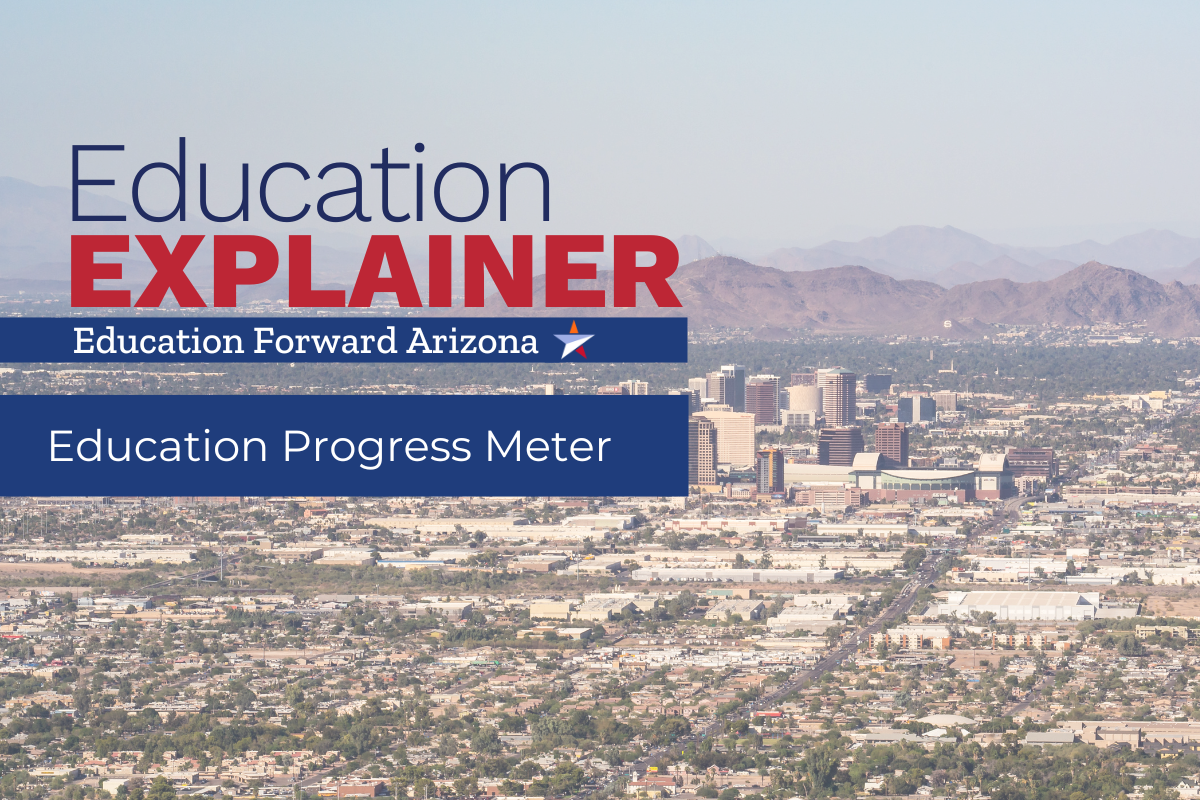
Education Explainer: Education Progress Meter
Education Forward Arizona, in partnership with the Center for the Future of Arizona, recently released the annual update for the Education Progress Meter. This nonpartisan data tool is used to show what it will take to reach our state’s Achieve60AZ goal based on eight indicators representing early, K-12, and postsecondary education.
Since the inception of the Education Progress Meter in 2015, progress was made in each of the metrics until the COVID Pandemic, which impacted each of the metrics. We are slowly making our way back to pre-pandemic levels but have hit a momentary plateau. While Arizona has a way to go to reach our established educational goals, you will see a bright spot in the Quality Early Learning metric. This metric measures the percentage of 3- and 4- year-old children who are in a high-quality early learning environment and increased from 21% to 27%. We believe a reason for this positive increase is a result of the additional federal resources that were allocated to support quality early learning in Arizona.
The History of the Education Progress Meter
In 2015, leaders from education, business, and policy makers came together to discuss the state of education in Arizona. It was decided that by identifying and tracking specific metrics, focused attention could be given to ensure that Arizona is meeting the educational needs of students in the P20 sector that would lead to a strong and vibrant Arizona. At the time, it was believed that in order for Arizona to be prepared to meet the workforce needs of the near future, 60 percent of all adults between the ages of 25 and 64 would need a postsecondary credential that includes industry certificates, associate degrees, or bachelor degrees by 2030, creating the Achieve60AZ Goal.
The Purpose of the Education Progress Meter
The purpose of the Education Progress Meter is to be a tool to support schools as they prepare students for academic success throughout the P20 pipeline, with the ultimate goal of increasing the attainment rate of postsecondary credential and degrees. The process of determining the eight indicators, data sources, and goals that make up the Education Progress Meter framework was not taken lightly or conducted in a vacuum. The goal-setting process was led by content experts and involved the participation of nearly 200 individuals and organizations from across the state. Great effort was taken to involve and get feedback from as many stakeholders as possible.
The folks at the Center for the Future of Arizona have a robust data team that gathers specific data from various sources and provides an annual update for each metric. It is important to recognize that several of these metrics can be parsed out by many characteristics and can also be drilled down by city, district, and individual schools. Arizona has a very diverse racial and ethnic population; most notably, Arizona has the fifth largest Hispanic/Latino population in the United States, and close to 50-percent of students in the K-12 system are Hispanic/Latino. We encourage you to drill into the data, recognizing that Arizona has an opportunity to close the education gaps that currently exist across racial/ethnic groups; this is known as an Equity Gap and is a concern across the nation.
The Seven Education Progress Meter Metrics
We encourage you to follow the link to our website and read about the methodology for each metric. You can use this tool to explore the data at the state, county, city, district and school level, where appropriate.
For additional information, please view the update from the Center for the Future of Arizona.
Arizona Education Progress Meter Updates
| Metric/Indicator | Current Data Timeframe | Prev. | Current Data | % Change (previous > new) | Statewide 2030 Goal |
| Quality Early Learning Percent of 3- and 4-year-old children in high-quality early learning settings | 2022 Year | 21% | 27% | +6% | 45% |
| Third-Grade Reading Percent of third graders who pass their English Language Arts standardized test | 2023 Cohort | 41% | 41% | – | 72% |
| Eighth-Grade Math Percent of eighth graders who pass their Mathematics standardized test | 2023 Cohort | 27% | 27% | – | 69% |
| High School Graduation Rate Percent of high school class who graduate in 4 years | 2022 Cohort | 76% | 77% | +1% | 90% |
| Post-High School Enrollment Percent of high school graduates who enroll in a post-secondary institution the year following graduation | 2022 Cohort | 48% | 48% | – | 70% |
| Opportunity Youth Percent of 16-24-year-old Arizonans who are not in school or working | 2023 Year | 12% | 12% | – | 7% |
| Post-Secondary Attainment Percent of Arizonans 25-64 years of age with any post-secondary credential, including a degree or professional certification | 2023 Year | 48% | 48% | – | 60% |
